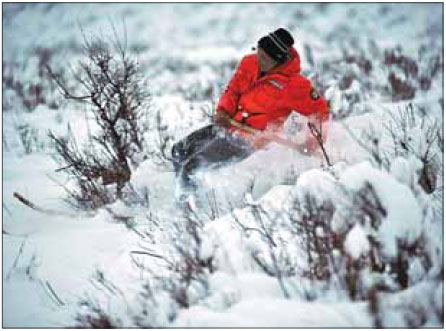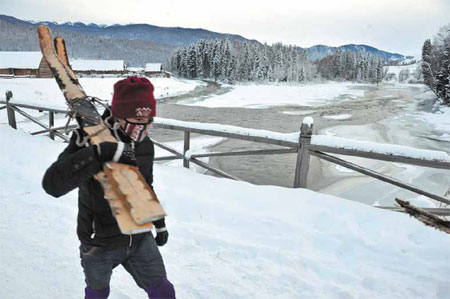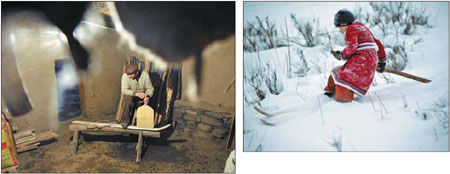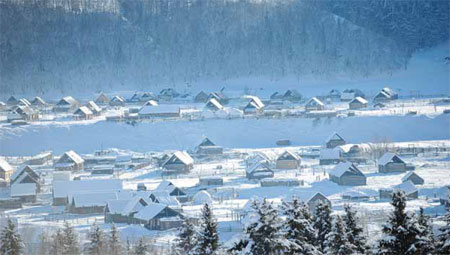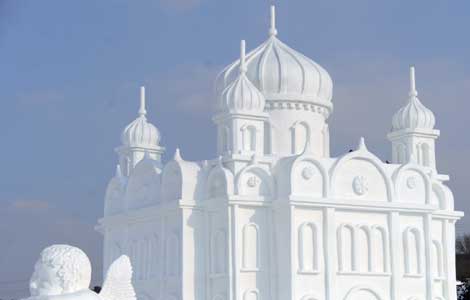Traditional skiing lives on as fur flies
Updated: 2014-01-15 07:19
By Cui Jia (China Daily USA)
|
||||||||
Ancient techniques help villagers survive the winter, Cui Jia reports from Altay, Xinjiang Uygur autonomous region.
A snowboard protruded from thick snow in a corner of the courtyard outside Sengelite's house in the village of Hemu.
It was presented to the 31-year-old ethnic Tuvan man as a prize for winning a traditional skiing contest in Altay prefecture in the Xinjiang Uygur autonomous region in 2010.
While we spoke, Sengelite planed a new set of skis made from spruce. Before he nailed strips of fur to the base of the skis, he called his son Yongdeng over to see if they were long enough for the 6-year-old's rapidly growing body.
"The skis must be about 20 centimeters longer than the skier's height. Yongdeng now finds it difficult to balance on the ones I made for him when he was 3," said Sengelite, measuring the boy's height against the skis.
Winter in Hemu, hidden deep in the Altay Mountains that border Kazakhstan, Russia and Mongolia, can last as long as seven months.
The snow can reach an average depth of 1.5 meters, meaning the village is often cut off from the outside world because roads become impassable for motorized transport.
To cope with the natural environment, the Tuvan, who are believed to be a branch of the Mongolian ethnic group, developed their unique skiing techniques. Some archaeologists believe the design of the skis can be traced back to the late Paleolithic era, also known as the Old Stone Age, around 12,000 years ago, judging by a rock painting of human figures skiing discovered near Altay city, about 200 kilometers from Hemu.
Experts say the primitive people who lived in the Altay area were very likely the first humans to master the art of skiing, and the Tuvan still employ the same techniques as those depicted in the painting.
Unlike modern skiers, the Tuvan use a single, long wooden pole held with both hands at the back of the skis to balance and steer. They also lean most of their body weight on the pole, rather like gondoliers.
The hand-made skis with bent tips, but no overall standard design, can cross the snow just as quickly as modern skis when descending, but there's one feature of fur skis that modern-day equipment can't match - the ability to ski uphill.
"During winter, we used skis to hunt moose in the mountains, so it's essential that we're able to move both up and downhill," Sengelite said. He shouted to Yongdeng, who had been climbing a hill on his skis, and speaking in Tuvan, a language completely unrelated to modern Mongolian and with no written form, shouted encouragement, urging the boy to go even higher.
When moving uphill, the coarse fibers of the fur dig into the snow, allowing the skiers to gain the necessary purchase, but they flatten down and become slick during a descent. "The fur has to come from the forelegs of horses because the hairs are long and thick. That makes the skis fast and durable," said Sengelite, as he signaled for Yongdeng, who has been learning the Tuvan ski tradition for three years, to come down and join us.
As he descended, Yongdeng tumbled into the knee-high snow. "I want him to join the village team in the annual fur-ski competition this month, so he needs to train harder," said Sengelite, whose victory in the 10,000-meter cross-county traditional skiing competition in 2010 won him the snowboard he proudly displays at the back of his house.
To help his son with the extensive training regime, Sengelite has built two snow slopes at different angles in his backyard, training aids that many lovers of winter sports can only dream of.
Hemu hasn't had as much snow as usual this winter. "We had two meters of snow in 2012. The horses can't walk when the snow is deep, so we have to ski to and from the village center. Every household uses fur skis; we can't live without them in winter," said Sengelite.
When winter arrives, motorized vehicles are redundant, so horse sleds and fur skis become the common modes of transport in the village, which is home to around 1,200 residents, most of them Tuvan. "Modern doesn't necessarily mean better," said Sengelite, while watching horse sleds ferry fodder and people up and down the mountain, following the tracks created by the constant traffic.
All the houses in Hemu are made of wood, an easily accessible material in a village surrounded by heavily wooded mountains. The extreme slant of the roofs prevents snow from accumulating on the tops of the houses and preventing them from collapsing under the weight.
Ancient rock painting
Unlike the Tuvans in Hemu, the residents of Handerte Mongolian township, where the famous rock painting was discovered in 2005, like to refer themselves as Wulianghai, a name given to the Tuvan during the Qing Dynasty (1644-1911).
The painting on the roof of the cave depicts human figures on skis, bending their knees as they travel alongside animals, including deer and moose.
An iron fence was erected at the entrance of the stone cave and a small museum was built. Later, a statue of a skiing Wulianghai man wearing traditional Mongolian costume was erected in the center of the township's small square. Since local archeologists declared Altay the birthplace of skiing in 2006, a fur-ski contest has been held every year.
Zhamuke and his friends were playing around the base of the statue on a sunny afternoon. He said everyone in the village knows how to ski. "I love skiing off the edges of rocks because it feels like flying," said the 10-year-old, who has been learning the skill since age 5, waving his arms in the air like wings.
Aolongbayier, deputy head of the township, said, "Although hunting moose is banned, the villagers in the mountains still use fur skis to hunt wild boar in the winter.The snow slows the animals down and because the Wulianghais are fast skiers, the boar become relatively easy to catch."
The 32-year-old said he's proud that a tradition that originated close to his hometown, possibly more than 12,000 years ago, remains practical and popular among local people. The 4,100 residents of the 30 households still make new skis every year, he added.
"Skiing has been closely related to hunting for centuries. The area around Altay has always had plenty of snow and animals in the forest, so the materials used for making fur skis have always been accessible. Also, the pattern and paint used, and tools made of stones discovered in nearby caves, all suggest that the painting could have been made by the primitive people who used the cave as shelter in the late Paleolithic Age," said Wang Bo, an archaeologist from Xinjiang Museum who has examined the painting.
Although the world's oldest ski, thought to be around 8,000 years old, was found in Russia, the Kazaks who live in the area also know how to make and use fur skis.
Ahelibek Ulalibek, from Nuogaite village near Altay, was unaware of the history of fur skis, but he knows how to make them - the skill has been passed down in his family from generation to generation.
The 54-year-old, who has been making skis for more than 10 years, made 50 pairs in 2012 and sold 30 of them last year. His customers included villagers who still hunt and local ski resorts which use them to attract visitors. "I also sold a pair to a Russian," he said proudly. When we met, he was busy making more skis in response to a large order from a ski resort.
High hopes
A pair of Ahelibek's skis costs around 750 yuan ($124) and can last three years. He said the most important part of the manufacturing process is the production of the curved tips, which are crucial for speed. The tips are made by dipping the ends of the polished wood in hot water, and then beating them while still wet.
His sons, aged 16 and 20, know how use both fur and modern skis because they often visit a ski resort close to their house. "They are quite good at skiing actually, but I want them to learn how to make fur skis, just as my father taught me."
"Snowboards are much easier to master than our traditional skis," said Sengelite. He and nine others from Hemu, including Yongdeng, will represent the village at the 2014 traditional skiing contest, which will be held at a resort in Altay on Jan 16.
Many ski resorts have been built in Altay since it was declared the birthplace of skiing and the local government has also been promoting the sports among school children.
"I will start teaching my son to snowboard when we get to the ski slopes - maybe someday he will become the first Chinese Tuvan to win an Olympic gold medal?" he smiled.
Contact the writer at cuijia@chinadaily.com.cn
|
Bayiritu from Hemu, a village in Altay, the Xinjiang Uygur autonomous region, displays his skiing skills. Experts say that primitive people who lived in the Altay area were probably the first humans to master skiing. Yao Tong / for China Daily |
|
A man in Hemu carries his skis. Experts say the primitive people who lived in the area long ago were probably the first humans to master the art of skiing. Photos by Yao Tong / for China Daily |
|
Above: Yongdeng, 6, practises his moves on a hill in Hemu village. Left: Ahelibek Ulalib is one of just a few people who can make fur skis, a skill passed down in his family. |
|
A bird's eye view of Hemu village, high in the Altay mountains in Xinjiang. |

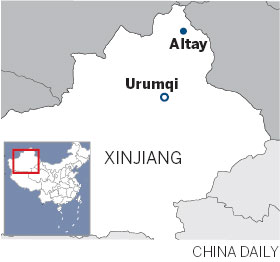
(China Daily USA 01/15/2014 page7)

 Detroit auto show features fuel-efficient cars
Detroit auto show features fuel-efficient cars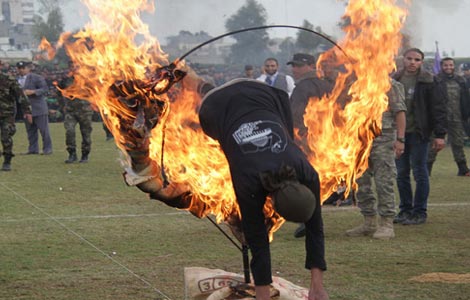
 Palestinian students show military skills
Palestinian students show military skills
 Cristiano Ronaldo wins FIFA best player award
Cristiano Ronaldo wins FIFA best player award
 Xuelong carries on mission after breaking from floes
Xuelong carries on mission after breaking from floes
 Beijing and Sofia vow new initiatives
Beijing and Sofia vow new initiatives
 71st Golden Globe Awards
71st Golden Globe Awards
 Bangkok unrest hurts major projects and tourism industry
Bangkok unrest hurts major projects and tourism industry
 No pant for cold subway ride
No pant for cold subway ride
Most Viewed
Editor's Picks
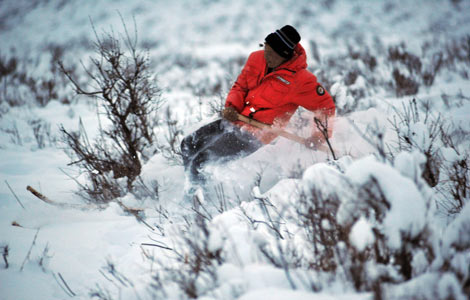
|
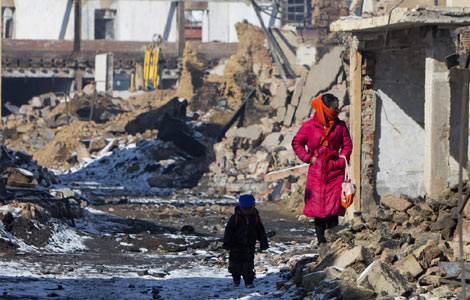
|

|

|

|

|
Today's Top News
Air China ups Houston-Beijing service to daily
Two students hurt in New Mexico school shooting
Chinese have new friend for US tours
15 flu-related deaths reported in Arkansas, US
New workstation in Silicon Valley
At least 16 dead in E China factory fire
Xi calls for reform to fight graft
S. China Sea rules no threat to peace
US Weekly

|

|
